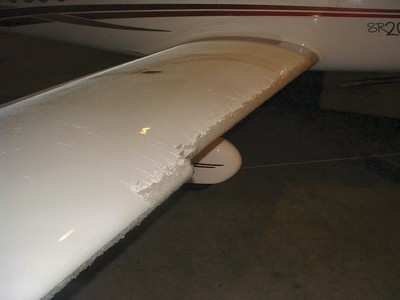Even Small Amounts Affect Aircraft Performance
 It is still two months before
winter officially begins, but there has already been snow in the
upper midwest (which makes me glad to be in Florida, ed.), so the
time to begin planning for winter flying is now.
It is still two months before
winter officially begins, but there has already been snow in the
upper midwest (which makes me glad to be in Florida, ed.), so the
time to begin planning for winter flying is now.
To that end, the FAA has issued an Information for Operators
(INfO) advisory focusing on small accumulations of ice, snow,
frost, and slush on aircraft surfaces, and their effect on aircraft
performance.
The circular states that, despite FAA and industry publications
cautioning pilots on the adverse affects that small amounts of
contamination can have on the aerodynamic performance and control
of aircraft, aircraft accidents and fatalities continue to be
attributed to this cause. Some pilots and operators still
mistakenly believe that aircraft are safe to fly with small amounts
of frost or other contaminants adhering to the aerodynamic and/or
control surfaces. Additionally some operators and pilots mistakenly
believe that contamination that is not on or near the leading edge
of the aerodynamic surface (e.g., the upper surface of the wing) is
not a factor.
According to the advisory, accident investigations, follow-up
research, and experience show that even very small amounts of
frost, snow, ice, or slush on the aerodynamic and/or control
surfaces of the aircraft can cause significant loss in lift and
flight control capability. These very small amounts of
contamination disrupt the smooth airflow over the airfoil surface
and cause loss of lift or effectiveness of control surfaces. In
several fatal accidents this loss of lift and controllability was
not apparent until the aircraft climbed out of ground effect; at
that time the aircraft began un-commanded roll and/or pitch
movements from which the pilot could not recover. Any amount of
contamination, no matter how spotty or thin in feel and sight, nor
its location, must be removed from all aerodynamic and control
surfaces prior to flight.
Currently the best way to detect small amounts of contamination
is by looking at, and touching the surfaces. One way to detect
frost, snow, or ice is to test by scraping a fingernail or a
similar implement across the aircraft airfoil surfaces. Consider
the airfoil contaminated and remove the contamination prior to
flight if any portion of the surface looks or feels any different
than it does when it is dry, or when wet on an above freezing
day.
When testing, consider that what might appear to be very small
spots of contamination well aft of the leading edge of the airfoil
surface can magnify separation of the smooth airflow over the
airfoil surface. It must be removed prior to flight. Even the feel
or appearance similar to ultra fine sandpaper on the airfoil is not
acceptable.

The FAA recommends that directors of safety, directors of
operations, and aviation instructors ensure that their pilots and
students understand that even small amounts of contamination can
adversely affect the aerodynamic and control capability of the
aircraft. They should emphasize the best practices for detecting
small or thin amounts of contamination on the aircraft they
operate. Pilots should become familiar with the appearance and feel
of their aircraft’s aerodynamic and control surfaces when dry
and just wet so they have a reference to use as a baseline when
checking for contamination. When conditions favor frost development
and/or ground icing, pilots should be alert for small and/or thin
amounts of contamination on the aerodynamic and flight control
surfaces. Aircraft operating procedures should clearly convey that
any and all frost, snow, ice, and slush contamination, no matter
how spotty or thin, must be completely removed prior to flight.
 ANN's Daily Aero-Linx (04.15.24)
ANN's Daily Aero-Linx (04.15.24) Classic Aero-TV: 'No Other Options' -- The Israeli Air Force's Danny Shapira
Classic Aero-TV: 'No Other Options' -- The Israeli Air Force's Danny Shapira Aero-News: Quote of the Day (04.15.24)
Aero-News: Quote of the Day (04.15.24) Airborne 04.16.24: RV Update, Affordable Flying Expo, Diamond Lil
Airborne 04.16.24: RV Update, Affordable Flying Expo, Diamond Lil ANN's Daily Aero-Term (04.16.24): Chart Supplement US
ANN's Daily Aero-Term (04.16.24): Chart Supplement US




